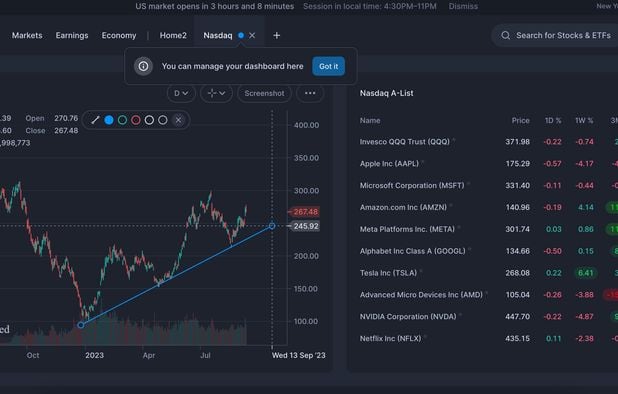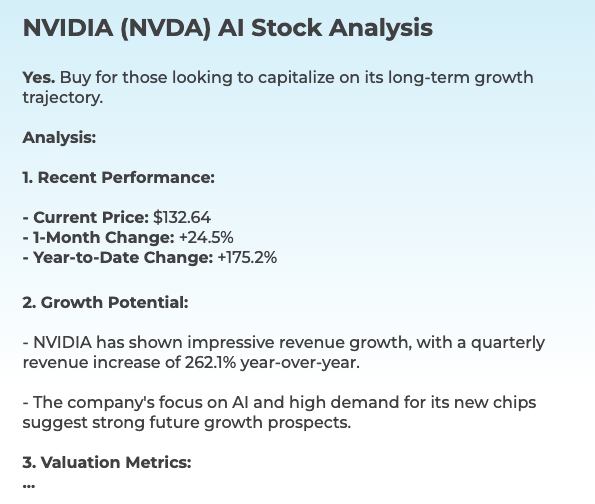20 Pro Pieces Of Advice For Deciding On AI Stock Prediction Sites
20 Pro Pieces Of Advice For Deciding On AI Stock Prediction Sites
Blog Article
Top 10 Tips For Evaluating The User Interface And Experience Of Ai Stock Predicting/Analyzing Trading Platform
The User Interfaces (UI) and the user experiences of AI-powered stock trading platforms are crucial to their efficiency, usability, overall satisfaction, and their overall performance. A poorly designed interface can hinder decision-making, even if the underlying AI models are reliable. Here are the 10 best tips for evaluating the UI/UX.
1. The ease of use and the ease of use of the product are assessed
Navigation: Ensure that the platform is easy to use, with buttons and menus that are easy to understand, as well as workflows.
Learning curve: Determine the speed with which a beginner can comprehend and utilize the platform, without requiring lengthy training.
Consistency: Check the patterns of design across all platforms for uniformity (e.g. buttons, colors, styles).
2. Check Customizability
Dashboard customization: Determine whether users are able to customize dashboards to display relevant data as well as charts and metrics.
Layout flexibility: The platform should let users move, rearrange, or move widgets.
Themes and preference. Check to see whether there are dark/light options or other preferences in the visual.
3. Examine the data Visualization
Chart quality: Ensure the platform provides high-quality, interactive charts (e.g., candlestick charts, line charts) with zoom and pan functions.
Visual clarity Ensure to ensure that the data is clearly presented, including labels, legends and tip-offs.
Real-time updates: Verify if visualizations update in real-time to reflect market changes.
4. Test for speed and reactivity.
Loading times: Ensure your platform loads fast, even when handling large datasets or complex calculations.
Real-time performance: Make sure the platform can respond to data feeds in a flash without delay or lags.
Cross-device compatibility : Make sure that the platform is compatible with all devices (desktops, mobiles, tablets).
5. Assess Accessibility
Mobile App: Make sure the platform has a mobile trading app with full functionality.
Keyboard shortcuts. Check to see if the platform offers keyboard shortcuts for users who are skilled.
Accessibility Features: Check if the platform adheres to accessibility standards.
6. Test Search and Filter functionality
Search efficiency: Ensure that the platform lets users swiftly look up indexes, stocks or any other asset.
Advanced filters - See whether you can apply filters, for instance by sector, market cap or performance metrics to narrow down the results.
Saved searches. Verify the platform's ability to allow users to store frequently used search terms or filters.
7. Be sure to check for alerts and notifications
Alerts that can be customized. Users are able to create alerts for specific situations (e.g. price thresholds or surges in volume).
Notification delivery - Check if alerts are being delivered via multiple channels.
Timeliness: Check if alerts are activated quickly and accurately.
8. Integrate with other tools
Broker integration: Make sure that your platform seamlessly integrates with your brokerage account to allow ease of execution of trades.
API access: Find out the API access for advanced users. the API to create their own software or workflows.
Third-party integrations: Determine whether the platform allows integrations with other software (e.g., Excel, Google Sheets or trading bots).
9. Review Support and Help Features
Tutorials on boarding: See whether the platform offers tutorials or walkthroughs for new users.
Help Center: Check that the platform has a complete and well-organized help centre.
Customer service: Check to determine if the platform offers an efficient customer support.
10. Test Overall User Satisfaction
User feedback: Read reviews and feedback from users to gauge their overall satisfaction with the platform's UI/UX.
Trial period: Try a free trial or demo to try the platform out for yourself and test its effectiveness.
How does the platform deal with edge cases and mistakes?
Bonus Tips:
Aesthetics: While functionality is key visual appeal, an appealing design can improve the overall user experience.
Performance under stress - Test the platform's stability and responsiveness during markets with high volatility.
Go to the community or forums to see if there is an active forum or user group in which members can share tips and give feedback.
Check these points to determine the UI/UX for AI stock predicting/analyzing platforms. This will ensure that they are efficient and user-friendly. They must also be able to meet the requirements of trading. The UI/UX of a trading platform could have a significant impact on your ability to make educated trades and take the most effective decisions. View the top rated AI stock trading app recommendations for blog info including stock ai, AI stock trading app, best AI stock, chart ai trading assistant, ai for stock predictions, market ai, AI stock picker, best ai trading software, ai for stock trading, ai investing and more.
Top 10 Tips On Risk Management Of Ai Trading Platforms That Can Predict Or Analyze The Price Of Stocks.
Risk management is an essential element of any AI stock predicting/analyzing trading platform that helps safeguard your investment and limit potential losses. Platforms with robust risk-management tools can help you navigate uncertain market conditions and make educated choices. Here are 10 tips on how you can evaluate the platform's risk management capabilities.
1. Review Stop-Loss and Take-Profit Features
Customizable settings: Make sure you can set the limit of take-profit or stop-loss for certain trades.
Check to see if your platform supports trailing stops which automatically adjusts as the market moves towards your.
Check if your platform allows you to make stop-loss orders that guarantee the closing of your trade at the price specified, even on unstable markets.
2. Utilize Position Sizing Tools
Fixed amount: Check that the platform you're using allows you to adjust position sizes according to a predetermined amount.
Percentage portfolio: Determine if the risk can be controlled proportionally by setting your portfolios as a percent of your portfolio's total.
Risk-reward-ratio: Determine if the platform allows users to set individual risk/reward ratios.
3. Make sure you have Diversification Support
Multi-assets trading: Verify that the platform can support trading across a variety of asset classes (e.g. ETFs, stocks options, forex, etc.) for diversification of your portfolio.
Sector allocation: Determine whether the platform has tools to monitor and control sector exposure.
Geographic diversification - Check that the platform allows the ability to trade on markets across the world. This can help diversify geographical risk.
4. Assess margin and leverage control
Margin requirements. Be aware of the requirements for margin prior to trading.
Find out if you can set leverage limits to limit the risk you take.
Margin call: Make sure that the platform has timely notifications for margin calls. This will help keep accounts from being closed.
5. Assessment of Risk Analytics and Reporting
Risk metrics. Make sure your platform provides you with key risk indicators (e.g. VaR Sharpe Ratio, Drawdown) that are pertinent to the portfolio you are managing.
Scenario Analysis: Find out whether your platform has the capability to simulate different market scenarios to determine the potential risks.
Performance reports: Ensure the platform provides you with detailed reports on performance, as well as returns that are adjusted for risk.
6. Check for Real-Time Risk Monitoring
Portfolio monitoring: Make sure the platform allows you to track your portfolio in real-time.
Alerts and notifications. Ensure that the platform sends out real-time alerts when risks occur (e.g. margin breaches, triggers for stop-loss orders).
Risk dashboards: Ensure the platform provides customized risk dashboards that give you a full picture of your personal profile.
7. Tests of Backtesting, Stress Evaluation
Stress testing - Make sure that your platform allows you to stress test strategies and portfolios under extreme market conditions.
Backtesting. Find out if the platform permits backtesting. This is the application of historical data to assess the risk and the performance.
Monte Carlo Simulators: Verify whether the software uses Monte Carlo models to model potential outcomes and determine the risk.
8. Risk Management Regulations: Assess your compliance
Ensure that the platform meets the requirements of regulatory compliance (e.g. MiFID II regulations in Europe, Reg T regulations in the U.S.).
Best execution: Ensure that the platform follows the most efficient execution methods. Trades are executed at the lowest price feasible to limit loss.
Transparency. Verify that the platform is transparent and provides clear disclosures about potential risks.
9. Look for parameters controlled by the user.
Custom risk rules: Ensure that the platform you choose lets you create your own unique risk management guidelines.
Automated risk control: Determine whether the platform is able to automatically enforce rules for risk management according to the parameters you have set.
Manual overrides See if you can manually override the risk management system in a situation of emergency.
Review Case Studies and User Feedback
User reviews: Study user feedback to gauge the platform's effectiveness in managing risk.
Case studies Find case studies, or testimonials that demonstrate the ability of the platform to manage risk.
Forums for communities: Find out if there's a vibrant community of traders who share their tips and strategies for risk management.
Bonus Tips
Trial period for free: Try the risk management features of the platform using real-world scenarios.
Support for customers - Ensure that your platform provides a solid support for questions and issues related to risk.
Check for educational sources.
These tips will help you evaluate the risk management capabilities of AI software for analyzing and predicting stocks. So, you'll be able to pick a platform that safeguards your capital and limits potential losses. To ensure that your trading is successful and navigate volatile markets, robust risk management tools are crucial. Check out the recommended trading ai tool for website info including AI stock investing, AI stock price prediction, chart analysis ai, stocks ai, best ai penny stocks, chart ai trading, investing with ai, ai in stock market, ai software stocks, ai software stocks and more.